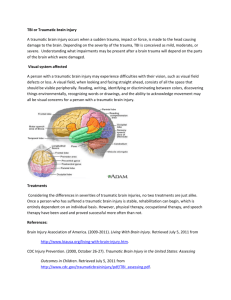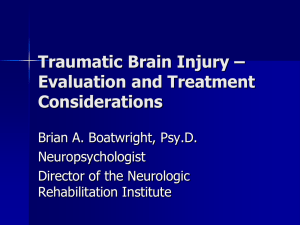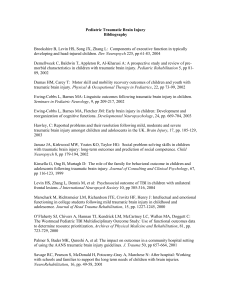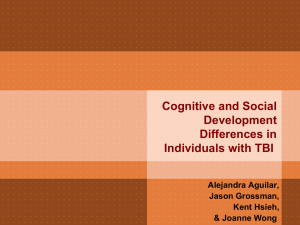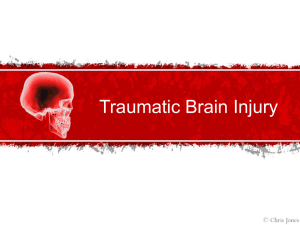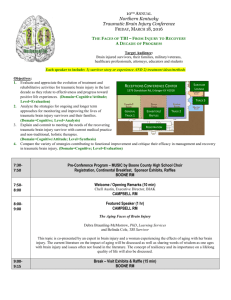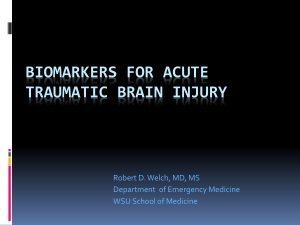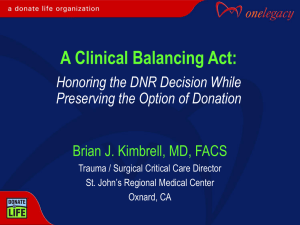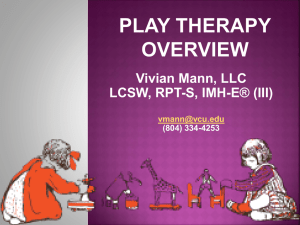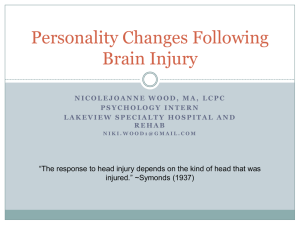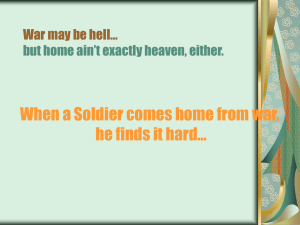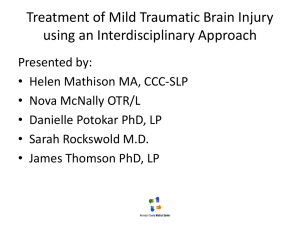Psychopathology - New Zealand Institute of Medical Radiation
advertisement
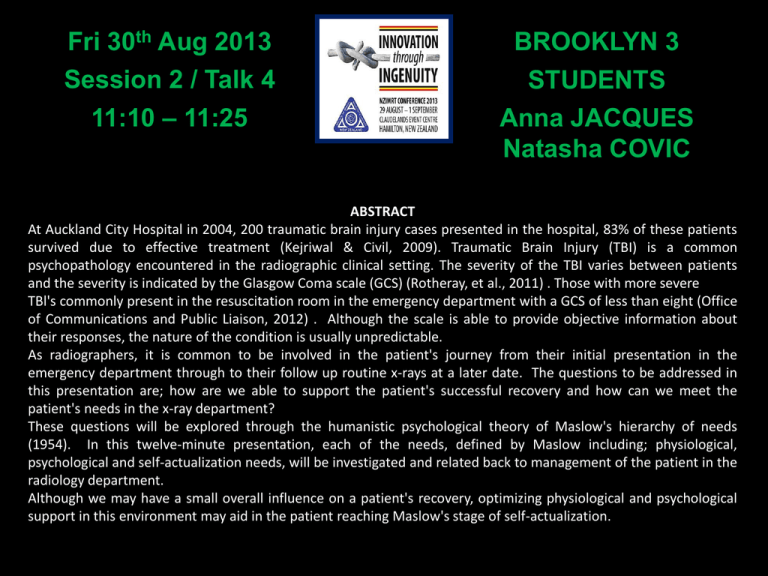
Fri 30th Aug 2013 Session 2 / Talk 4 11:10 – 11:25 BROOKLYN 3 STUDENTS Anna JACQUES Natasha COVIC ABSTRACT At Auckland City Hospital in 2004, 200 traumatic brain injury cases presented in the hospital, 83% of these patients survived due to effective treatment (Kejriwal & Civil, 2009). Traumatic Brain Injury (TBI) is a common psychopathology encountered in the radiographic clinical setting. The severity of the TBI varies between patients and the severity is indicated by the Glasgow Coma scale (GCS) (Rotheray, et al., 2011) . Those with more severe TBl's commonly present in the resuscitation room in the emergency department with a GCS of less than eight (Office of Communications and Public Liaison, 2012) . Although the scale is able to provide objective information about their responses, the nature of the condition is usually unpredictable. As radiographers, it is common to be involved in the patient's journey from their initial presentation in the emergency department through to their follow up routine x-rays at a later date. The questions to be addressed in this presentation are; how are we able to support the patient's successful recovery and how can we meet the patient's needs in the x-ray department? These questions will be explored through the humanistic psychological theory of Maslow's hierarchy of needs (1954). In this twelve-minute presentation, each of the needs, defined by Maslow including; physiological, psychological and self-actualization needs, will be investigated and related back to management of the patient in the radiology department. Although we may have a small overall influence on a patient's recovery, optimizing physiological and psychological support in this environment may aid in the patient reaching Maslow's stage of self-actualization. Separate Video File Psychopathology Traumatic brain Injury What is a psychopathology? “A study of mental disorders; another name for abnormal psychology” (Colman, 2001, pg. 601) Traumatic Brain Injury (TBI) Trauma: “injury that results when energy is transferred from the environment to human tissue” (Emergency Nurse Association, 2005, pg. 599) Mechanisms: -Open Head injury -Closed Head injury -Deceleration injury (Traumatic Brain Injury, n.d) Glasgow Coma Scale (GCS) A scale that determines the neurological level of consciousness of a person through evaluation of motor, visual and verbal response. Each category is rated out of 5 – Fully conscious person = 15 – Brain dead = 3 (Traumatic Brain Injury, n.d) TBI Mild GCS 13-15 Symptoms: Headache Confusion Light headedness Ears ringing Moderate GCS 8-13 & No conscious response Worsening headache Vomiting and Nausea Convulsions/ seizures Slurred speech Loss of co-ordination (Office of Communications and Public Liaison, 2012) Severe GCS <8 (Office of Communications and Public Liaison, 2012) TBI Patient Demographics: (Schatz, n.d.) (Kejriwal & Civil, 2009) MASLOW’S (1954) HIERACHY OF NEEDS (The McGraw-Hill Companies, 2011) (The McGraw-Hill Companies, 2011) Fundamental Needs Physiological needs Nature of the Condition - Consciousness - Assistance in fulfilling basic needs (Gentleman, Dearden, Midgley, & Maclean, 1993) Treatment - Airway, breathing, circulation - Surgery Management in Radiography Department - Portable/Mobile CXR - CT studies - Careful handling – Bone flap, other injuries (The McGraw-Hill Companies, 2011) Fundamental Needs Safety needs: Nature of the Condition -Disorders of Memory -Disorders of Attention -Disorders of Language (Granacher, 2003) Treatment - Reassurance - Acceptance of loved ones Management in Radiography Department -Regular CXR -Encouragement and acceptance -Keeping the patients dignity in tact -Be aware of aggression and uncooperativeness (The McGraw-Hill Companies, 2011) Psychological needs Belongingness and Esteem: Nature of the Condition -Apathy -Agitation & frustration -Depression -Diminished self awareness -Impulse control (Walter, Angelle, Margaret, & Karen, 2005) Treatment -Pharmacological vs. Non-pharmacological (Walter, Angelle, Margaret, & Karen, 2005) Management in Radiography Department - Encouragement - Be accepting - Keeping the patients dignity in tact (The McGraw-Hill Companies, 2011) Self actualization Self-actualization traits: -Being self-accepting of who they are -“look at life objectively” (McLeod, 2007, para. 14) -Deep appreciation of simple aspects of life Personal Experience (The McGraw-Hill Companies, 2011) REFERENCES Bullock, R., Chesnut, R., Ghajar, J., Gordon, D., Hartl, R., Newell, D., et al. (2006). Surgical Management of TBI. Neurosurgery , 1-3. EdVisions. (2010). Belongingness. Retrieved August 10, 2012, from The Hope Survey: http://www.hopesurvey.org/what-were-measuring/belongingness Emergency Nurse Association. (2005). Sheehy's Manual of Emergency Care. Missouri: Elsevier Mosby. Gentleman, D., Dearden, M., Midgley, S., & Maclean, D. (1993). Guidelines for resuscitation and transfer of patients with serious head injury. Education and Debate , 547-552. Granacher, R. (2003). Traumatic Brain Injury: Methods for Clinical and Forensic Neuropsychiatric Assessment. London: CRC Press. Kejriwal, R., & Civil, I. (2009). Time to definitive care for patients with moderate and severe traumatic brain injury—does a trauma system matter? The New Zealand Medical Journal , 122, 40-46. McLeod, S. (2007). Maslow's Hierarchy of Needs. Retrieved August 17, 2012, from Simply Psychology: http://www.simplypsychology.org/maslow.html Office of Communications and Public Liaison. (2012, June 14). NINDS Traumatic Brain Injury Information Page. Retrieved August 10, 2012, from National Institute of Neurological Disorders and Stroke: http://www.ninds.nih.gov/disorders/tbi/tbi.htm#What_is Rotheray, K., Cheung, P., Cheung, C., Wai, A., Chan, D., Rainer, T., et al. (2011). The Glasgow coma scale (GCS) was originally described in trauma patients and is a tool which allows standardized recording of a patient's level of consciousness. Resuscitation , 86-89. Schatz, P. (n.d.). Traumatic Brain Injury Demographics. Retrieved August 10, 2012, from Schatz: http://schatz.sju.edu/neuro/epidem/demograph.html The McGraw-Hill Companies. (2011). Theories of Development. Retrieved August 10, 2012, from Higher Education: http://highered.mcgrawhill.com/sites/dl/free/0073370428/666687/Crandell9e_ch02.pdf Traumatic Brain Injury. (n.d). What are the Causes of TBI? Retrieved August 10, 2012, from Traumatic Brain Injury: http://traumaticbraininjury.com/understanding-tbi/%20what-are-the-causes-of-tbi/ Walter, H., Angelle, S., Margaret, S., & Karen, H. (2005). Rehabilitation for Traumatic Brain Injury. New York: Oxford. Weiten, W., Dunn, D., & Hammer, E. (2012). Psychology Applied to Modern Life. Belmont: Wadsworth. Zollman, F. (2011). Manual of Traumatic Brain Injury Management. New York: Demos Medical Publication.
